Though the Northern Irish city of Belfast has had a turbulent and troubled history, it has nonetheless proven itself as a thriving and culturally rich hub over recent years and is a growingly popular tourist destination.
The city is famous for being the location where the infamous Titanic ship was constructed, and it remains inextricably tied to the city’s identity, where there is an entire district known as the Titanic Quarter.
There is also an incredibly rich cultural scene in Belfast, with a plethora of theatres, music venues, and a glorious array of artwork adorning the streets.
However, venture out of the city centre, and you will discover a multitude of historic castles that demonstrate an alternative side to Irish heritage, that is not visible in the centre of Belfast.
This list will highlight the best castles that are located near Belfast, their key points of interest, as well as practical information, such as location, as well as opening and closing times.
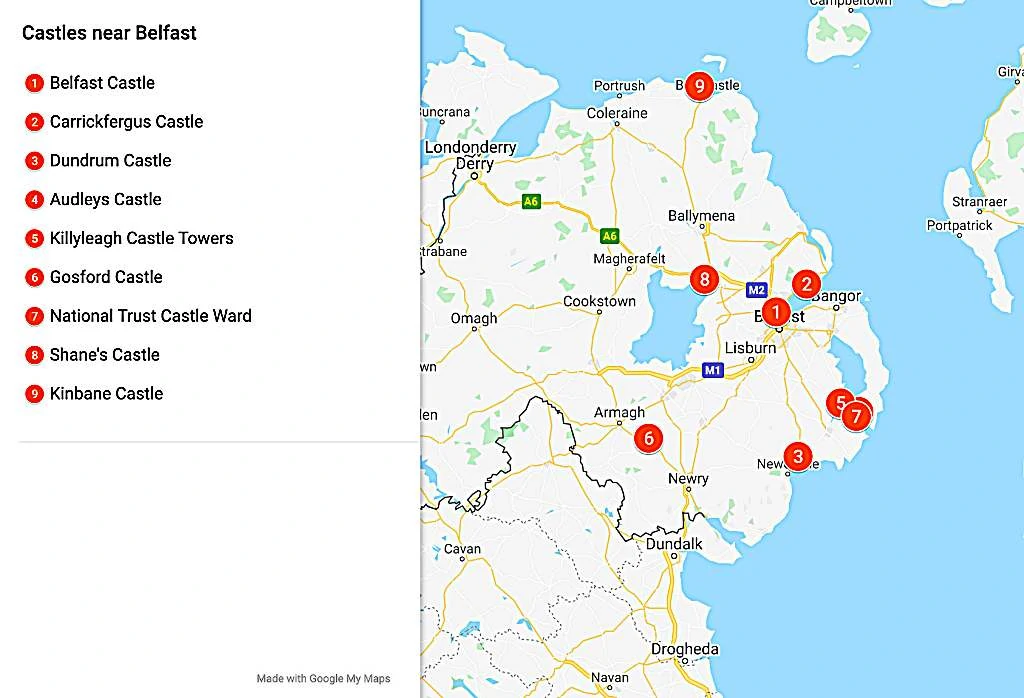
The best 9 castles to visit near Belfast
1. Belfast Castle
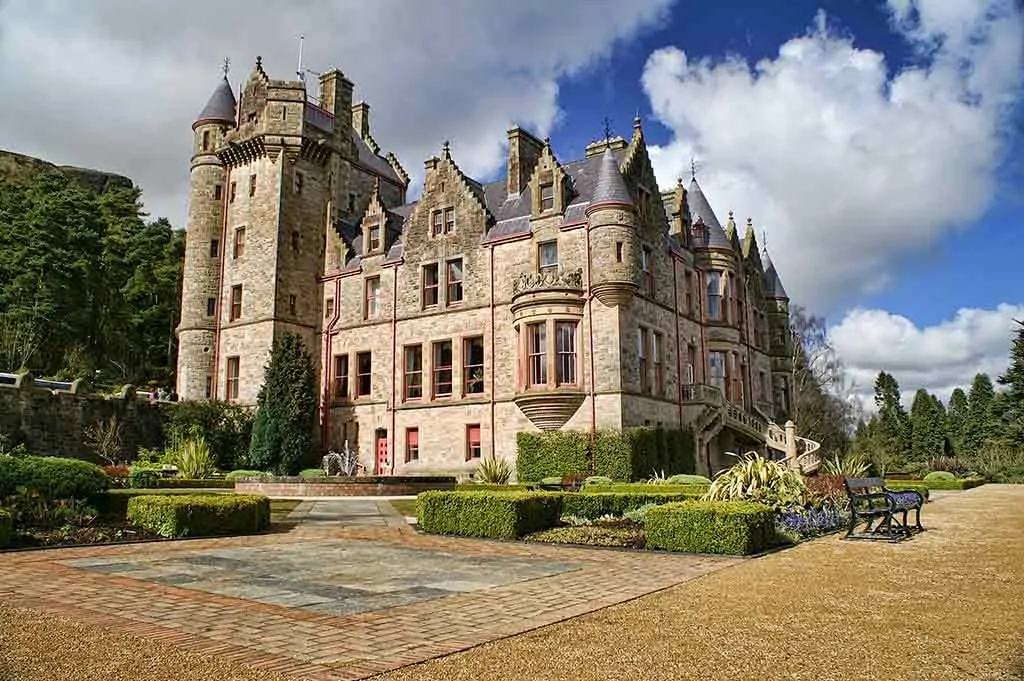
Originally built during the 12th century, by the Normans, the stunning Belfast Castle is located in the city centre, and has a rich and fascinating and history.
The original castle was made of materials that could not stand the test of time and the various military conflicts that were held at the site, so it was later replaced in 1611 with a stronger, stone and timber castle; it was replaced by the Baron of Belfast, Sir Arthur Chichester, though unfortunately, it later burned down in the year 1708.
After this, the castle was not rebuilt, but an entirely new castle was made on Cave Hill, whereby construction began in 1862 and ended in 1870.
Today, the castle is open to the public, and there are many great facilities on-site, such as a visitor centre, a restaurant, and an antique shop; visitors can wander around the interiors of the castle, that has been modelled in the style of the 1920s.
Where: Belfast, Northern Ireland
When: 19th century
Style: Neo-Gothic
Open for visit: Yes, for more information check here.
2. Carrickfergus Castle
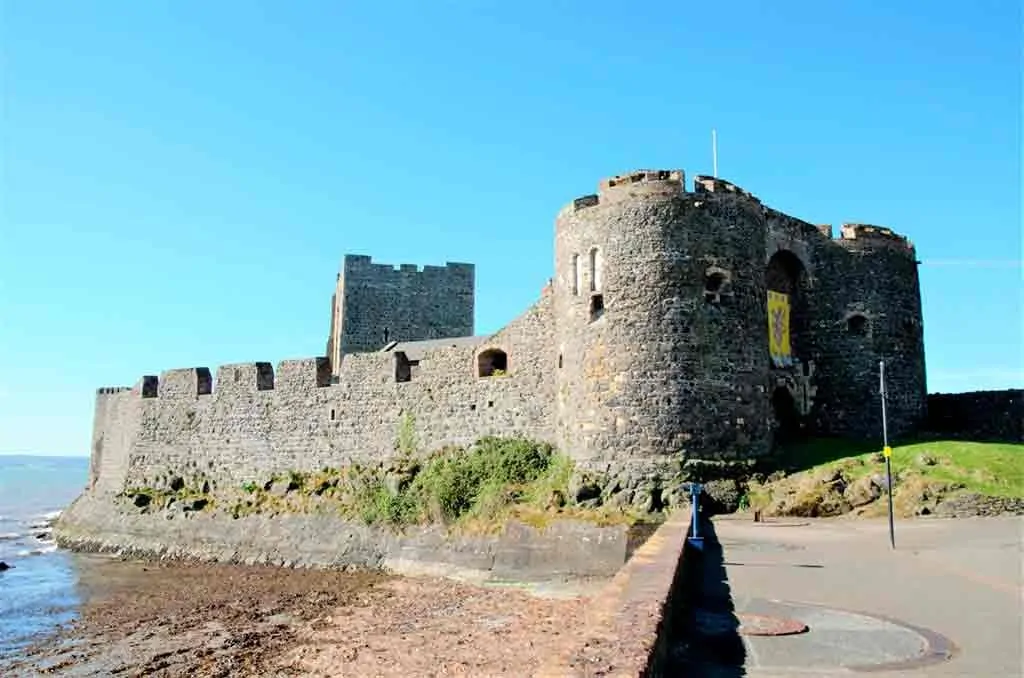
Situated in the town of Carrickfergus in County Antrim, which is located on the northern shore of Belfast Lough, lies the stunning and historic Norman castle, Carrickfergus Castle.
The castle was originally constructed in the year 1177, and was built by John de Courcy, with the purpose of being his headquarters after conquering eastern Ulster in the same year; de Courcy ruled as a petty king until the year 1204.
The castle later fell into the hands of the English, after King John sieged it in the year 1210; during the 13th century, many additions were added to the castle, such as some stunning Romanesque style double windows, gatehouses and towers.
Today, the castle is open to the public, and many visitors head to the castle as a day trip, to escape the hustle and bustle of Belfast city centre.
Where: Carrickfergus, Northern Ireland
When: 1177
Style: Romanesque
Open for visit: Yes, for more information check here.
3. Dundrum Castle

Towering above the scenic town of Dundrum in Country Down in Northern Ireland, lies the beautiful Dundrum Castle, which has a rich and fascinating heritage. Construction on Dundrum Castle began at the beginning of the 13th century and was built by John de Courcy, after his invasion of Ulster.
The castle was built with the purpose of controlling the access into the town of Lecale from the west and south directions, and it is also built upon a large hill, for purposes of watching.
Like many castles in Northern Ireland, the role and appearance of Dundrum Castle changed over the centuries, depending on the needs and styles of the time; it was renovated on several different occasions, with each time bringing with it new additions.
Today, the castle is open to the public, who come and visit to admire the stunning Norman architecture and try to uncover the secrets of the past.
Where: Dundrum, Northern Ireland
When: 13th century
Style: Norman
Open for visit: Yes, for more information check here.
4. Audleys Castle
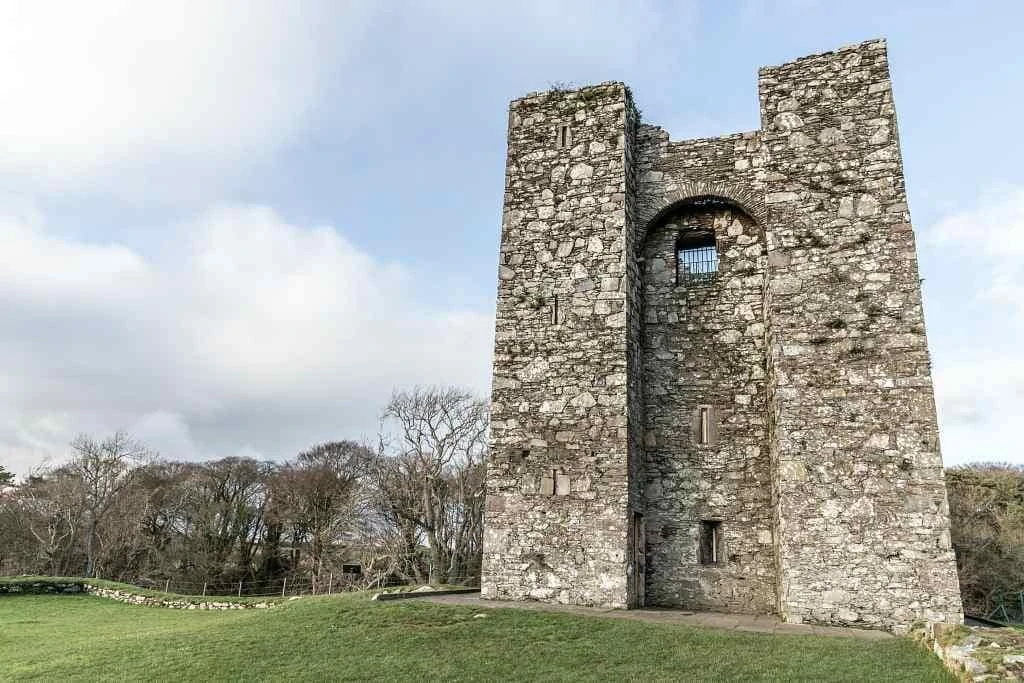
Located to the north-east of Strangford, in Northern Ireland’s County Down, which is not too far from Belfast, lies the stunning Audley’s Castle, which is an impressive 15th-century castle, or a tower house.
The castle was originally built in the 15th century, though it is believed that an earlier castle existed on its site, though little is known about its early history.
The name of the castle derives from the names of the Audley family, who owned the castle during the 16th century; they were a Hiberno-Norman family, who were prominent landowners in the 13th century.
Later, the castle was sold to the Ward family, in the year 1646. Today, Audley’s Castle tower house is a State Care Historic Monument, and it is open to the public; it makes for a great day trip from Belfast, to escape the business and hustle and bustle of the city.
Where: Strangford, Northern Ireland
When: 15th century
Style: Medieval
Open for visit: Yes, for more information check here.
5. Killyleagh Castle Towers

Situated in the idyllic village of Killyleagh, in County Down, lies the stunning Killyleagh Castle Towers, which is a beautiful and historic castle.
It was originally settled in the 12th century by John de Courcy, who was a Norman knight, and the castle was constructed in the year 1180; its initial function was to be part of a series of fortifications built as protection against the Vikings.
Since the 17th century, the castle has been owned by the Hamilton family, and it is currently resided in by Gawn Rowan Hamilton, a descendant, and his young family; the family occasionally host concerts at the castle, with famous performers including Van Morrison and Bap Kennedy.
The castle was redesigned in the 19th century by the famous architect Sir Charles Lanyon, in the style of a Loire Valley Chateau, which is why the castle looks somewhat more French than Irish in style.
Where: Killyleagh, Northern Ireland
When: 12th-century origins
Style: Loire Valley Chateau influence
Open for visit: The castle is a private residence so is not open to the general public
You might also be interested in:
6. Gosford Castle
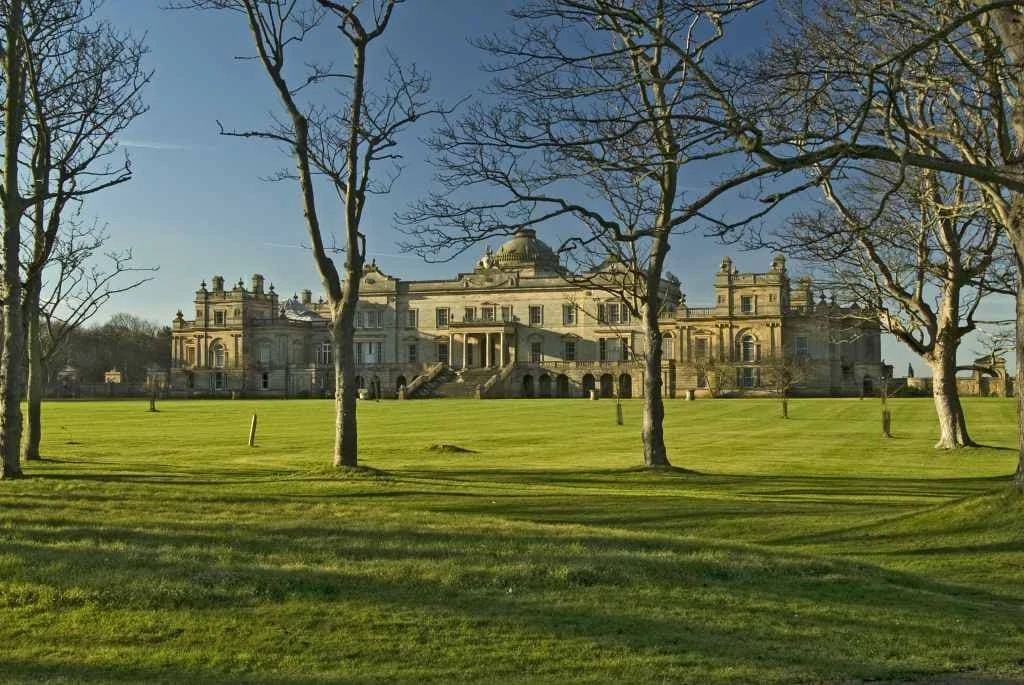
Situated in the town of Gosford in County Armagh in Northern Ireland, is the impressive and historic Gosford Castle. In the year of 1610, the Acheson family were granted a large portion of land in County Armagh, by James VI and I; they founded the village of Markethill, and a castle, though it was later demolished during the Irish Rebellion of 1641.
In the place of this castle, a new one was constructed, and it was owned by the same family until the year 1840.
During the 19th century, a new house was built and was constructed in the popular Norman revival style, under the lead of Thomas Hopper, who was commissioned by the Acheson family.
Today, the castle is a Grade A listed building and is believed to be the largest castle in the entirety of Ulster. Today, the castle is a private residence, so the inside cannot be visited by the general public.
Where: Gosford, Northern Ireland
When: 17th century
Style: Norman Revival
Open for visit: A private residence that is unfortunately not open to the public
7. Castle Ward

Situated near to the village of Strangford in County Down, Northern Ireland, lies the scenic, grand and impressive Castle Ward.
The castle has been the residence of the Ward family since approximately the year 1570 after it was bought by Bernard Ward from the Earls of Kildare, who had previously and historically owned it.
The castle that stands today was built during the early 1760s, and it has many Gothic style features and elements, such as the north-east façade, which boasts domineering turrets, dramatic windows, and a dark grey colouring.
The castle is open to the public, and has a whopping 332 hectares of landscaped gardens, which are perfect for taking an afternoon stroll around; there are also many facilities on the estate, and other aspects of history, such as a fortified tower house, theatre, Victorian laundry, and a shop.
Where: Strangford, Northern Ireland
When: 16th century
Style: Neo-Gothic
Open for visit: Yes, for more information check here.
8. Shane’s Castle
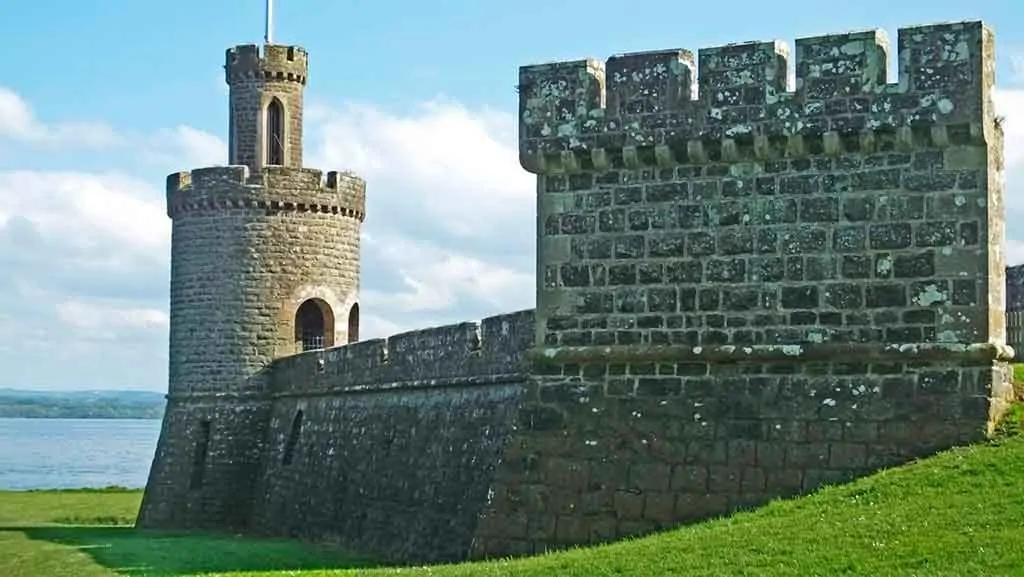
Located near to Randalstown in Country Antrim, which is not too far away from the city of Belfast, lies Shane’s Castle, or as it was formally known, Edenduffcarrick.
The castle was originally built in the year 1345, by a member of the Clandeboy O’Neill dynasty, who was a historic Irish clan, that occupied south County Antrim, and north County Down.
The name of the castle was changed to ‘Shane’s Castle’ in the 18th century and was named after the grandfather of Brian O’Neill, whose name was Shane.
There is lots of folklore attached to Shane’s Castle, that has fascinated visitors for centuries; for example, the Shane’s Castle Banshee, which is said to still haunt the site. Today, the castle is open to the public, and it makes for a perfect day trip from Belfast.
Where: Randalstown, Northern Ireland
When: 1345
Style: Medieval
Open for visit: By appointment only during the Summer season.
9. Kinbane Castle
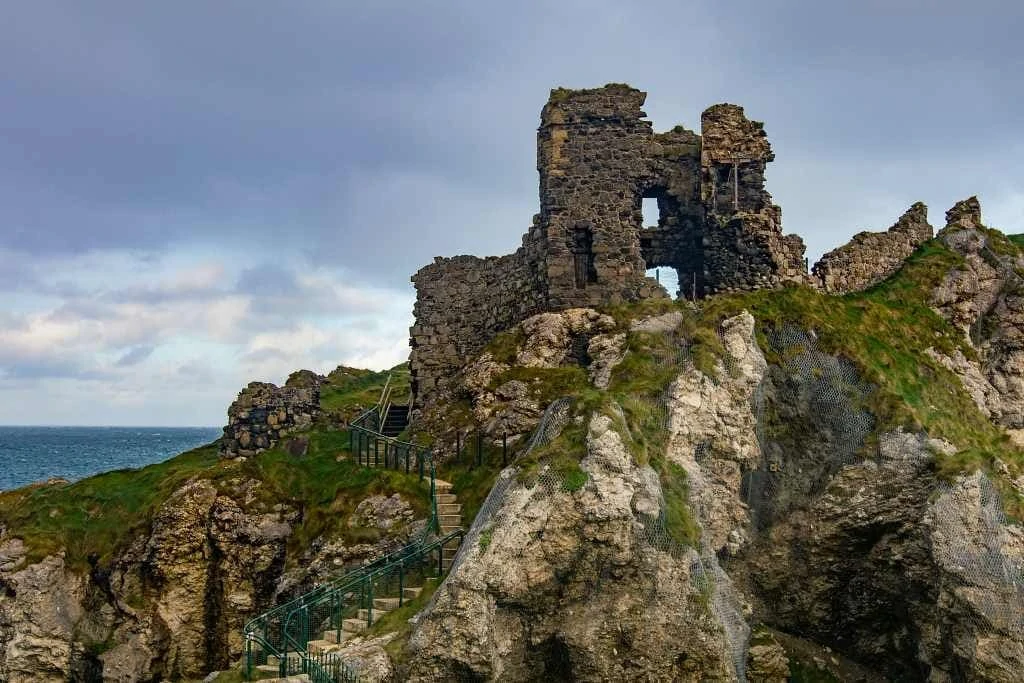
Kinbane Castle – Situated in the beautiful County Antrim, on some of Northern Ireland’s most stunning and dramatic natural coastal scenery, lies the historic Kinbane Castle, which translates to White Head Castle.
It is built upon a long and narrow stretch of limestone, which heads into the sea, and the only way of accessing it is by embarking on the thin and ragged pathway that leads to it.
The castle was initially built in the year 1547, by Colla MacDonnell, who was the brother of Sorley Boy MacDonald; later in the year 1551, the castle was sieged by the English, and again in 1555, whereby it was partially demolished.
It was later rebuilt, and it played a crucial role in several key military battles and conflicts. Today, the castle is mere ruins, but it nonetheless provides visitors with a key to the past; many visitors also come to the site to admire the stunning natural scenery that envelops the castle.
Where: County Antrim, Northern Ireland
When: 16th century
Style: Medieval
Open for visit: Yes, open 24/7
